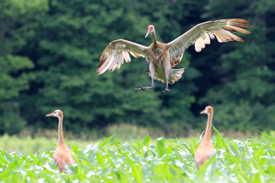Hunting could hurt genetic diversity of sandhill cranes, UW research suggests
As Wisconsin lawmakers debate whether to establish a hunting season for sandhill cranes, they may want to consider more than just the sheer number of birds, suggests a University of Wisconsin–Madison specialist in avian genetics.

Research using DNA fingerprinting suggests that hunting sandhill cranes like these could harm their genetic diversity.
A recent analysis of the crane’s eastern population — which includes birds that spend their summers from the Midwest to the East Coast — indicates it also may be important to take into account the distribution of the bird’s genetic diversity across the landscape.
“Wisconsin sandhill cranes went through a genetic bottleneck in the 1930s when they almost went extinct, and now we’re starting to see a rapid increase in their population density and that’s great,” says Mark Berres, an assistant professor of animal sciences, who led the study. “But the genetic structure of the entire population is anything but uniform. We’re finding that there are a lot of distinct breeding populations, including some in Wisconsin. These are unique sub-populations that are genetically distinct from all others.”
With funding from the U.S. Fish and Wildlife Service, Berres used DNA fingerprinting to assess the genetic makeup of cranes across the Eastern population’s range. While he found a surprisingly good amount of genetic diversity throughout the population and quite a bit of genetic mixing, there were also a significant number of isolated sub-populations.
The unique genes in these populations could prove vital to the survival of the overall sandhill crane population down the line, perhaps giving the birds the ability to survive new diseases or adapt to changing environmental conditions, Berres explains. But because these sub-populations are relatively small, they are more vulnerable to hunting pressure.
“If people start harvesting them, I’m not sure how stable these populations will be,” says Berres. “It’s possible that if hunters are allowed to take 20 percent of the overall population, they could inadvertently take 99 percent of a particular sub-population.”
From a low of just 25 mating pairs in the late 1930s, as estimated by famed naturalist Aldo Leopold, Wisconsin’s sandhill crane population has rebounded thanks to a number of factors, including habitat conservation, increased farm acreage and hunting regulations. There are now more than 20,000 birds in the state, although this number is still significantly lower than historical levels.
“We have a pretty good understanding of why the birds are doing so well, but we’re really just starting to figure out the population’s breeding structure,” says Berres. “To me it screams ‘don’t touch them.'”




